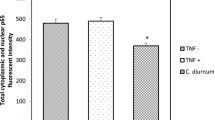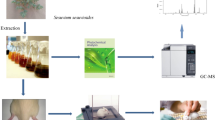Abstract
People of Pakistan have undisturbed customs for the employment of medicinal plants for healthcare requisites. Chloroform extract of F. hygrometrica (CE FH) was examined for its ability to reduce inflammation and to produce analgesia. Carrageenan and formalin-induced paw edema model for inflammatory activity, hot-plate and tail-flick methods to assess analgesic activity were executed. Phytochemical analysis was done by UHPLC–MS and GC–mass spectrometer. The results demonstrated that in carrageenan-induced paw edema, maximum reduction in inflammation was observed at 5th hour at the dose 100 mg/kg; while at doses 250 and 500 mg/kg, maximum response was observed at 5th and 6th hours. Analgesic activity results indicated that maximum analgesia was observed up to 120 min at 100 mg/kg, while up to 90 min in case of 250 and 500 mg/kg doses. The formalin-induced rat paw edema showed significant (p < 0.05) anti-inflammatory activity after 5 days treatment. After, testing period of 10 days, the biochemical parameters such as CBC, CRP, serum enzymes like CAT, SOD, GSH and inflammatory mediators like TNF-α, IL-6, IL-4 and IL-10 were estimated. The administration of formalin resulted in an increase in the level of leucocytes, total WBC, CRP, serum enzymes and in the diameters of paw thickness, while pre-treatment with CE FH at dose levels of 100, 250 and 500 mg/kg exhibited a diminution in the levels of SOD, GSH, CAT, total RBC and HB. Acute inflammatory mediators such as TNFα, IL -6 and IL-4 were reduced, and IL-10 was upregulated in the treated group as compared to the control. Many phytoconstituents, i.e., chitobiose, chlorovulone III, γ-tocotrienol, emmotin, cassine, hexacosanedioic acid, neophytadiene, fumaric acid, neophytadiene, hexadecanoic acid, phytol and stigmasterol were detected during UHPLC–MS and GC–MS analysis seems to be responsible for the said activity in correlation with the already reported data about these compounds. The results concluded that CE FH possess noteworthy anti-inflammatory and central analgesic action at different doses (100, 250 and 500 mg/kg).
Graphic abstract








Similar content being viewed by others
Data availability
All data generated or investigated in the study are included in this article.
References
Abubakar AR, Haque M (2020) Preparation of medicinal plants: basic extraction and fractionation procedures for experimental purposes. J Pharm Bioallied Sci 12(1):1
Allagui I, Horchani M, Zammel N, Jalouli M, Elfeki A, Kallel C, Hcini K (2022) Phytochemical characterization, antioxidant and anti-Inflammatory effects of Cleome arabica L. fruits extract against formalin induced chronic inflammation in female wistar rat: biochemical, histological, and in silico studies. Molecules 28(1):26
Amdekar S, Singh V, Singh R, Sharma P, Keshav P, Kumar A (2011) Lactobacillus casei reduces the inflammatory joint damage associated with collagen-induced arthritis (CIA) by reducing the pro-inflammatory cytokines. J Clin Immunol 31:147–154
Andrikopoulos NK, Kaliora AC, Assimopoulou AN, Papapeorgiou VP (2003) Biological activity of some naturally occurring resins, gums and pigments against in vitro LDL oxidation. Phytother Res 17:501–507
Anyasor GN, Okanlawon AA, Ogunbiyi B (2019) Evaluation of anti-inflammatory activity of Justicia secunda Vahl leaf extract using in vitro and in vivo inflammation models. Clin Phytosci 5:1–13
Andurkar SV, Gulati A (2011) Assessment of the analgesic effect of centhaquin in mouse tail flick and hot-plate tests. Pharmacol 88:233–241
Aparna V, Dileep KV, Mandal PK, Karthe P, Sadasivan C, Haridas M (2012) Anti-inflammatory property of n-hexadecanoic acid: structural evidence and kinetic assessment. Chem Biol Drug Des 80:434–439
Bakrim S, Benkhaira N, Bourais I, Benali T, Lee LH, El Omari N, Bouyahya A (2022) Health benefits and pharmacological properties of stigmasterol. Antioxidants 11(10):1912
Bhukya B, Anreddy RNR, William CM, Gottumukkala KM (2009) Analgesic and anti-inflammatory activities of leaf extract of Kydia calycina Roxb. Bangladesh J 4:101–104
Bouyahya A, Guaouguaou FE, El Omari N, El Menyiy N, Balahbib A, El-Shazly M, Bakri Y (2022) Anti-inflammatory and analgesic properties of Moroccan medicinal plants: phytochemistry, in vitro and in vivo investigations, mechanism insights, clinical evidences and perspectives. J Pharm Anal 12(1):35–57
Chang CW, Chang WT, Liao JC, Chiu YJ et al (2012) Analgesic and anti-inflammatory activities of methanol extract of Cissus repens in mice. Evid Based Complement Altern Med 2012:1–10
Ciufolini MA, Zhu S (1998) Practical synthesis of (±)-chlorovulone II. J Org Chem Res 63:1668–1675
Da Silva KA, Manjavachi MN, Paszcuk AF, Pivatto M, Viegas C Jr, Bolzani VS, Calixto JB (2012) Plant derived alkaloid (−)-cassine induces anti-inflammatory and anti-hyperalgesics effects in both acute and chronic inflammatory and neuropathic pain models. Curr Neuropharmacol 62:967–977
Fan X, Jiao X, Liu J, Jia M, Blanchard C, Zhou Z (2021) Characterizing the volatile compounds of different sorghum cultivars by both GC-MS and HS-GC-IMS. Int Food Res J 140:109975
Jan HA, Jan S, Bussmann RW, Wali S, Sisto F, Ahmad L (2020) Complementary and alternative medicine research, prospects and limitations in Pakistan: a literature review. Acta Ecol Sin 40:451–463
Jantaratnotai N, Thampithak A, Utaisincharoen P, Pinthong D, Sanvarinda P (2022) Inhibition of LPS-induced microglial activation by the ethyl acetate extract of Pueraria mirifica. Int J Environ Res Public Health 19:12920
John NAA, Shobana G (2012) Antiinflammatory activity of of Talinum fruticosum l. On formalin induced paw edema in albino rats. J Appl Pharm Sci 02:123–127
Javed F, Jabeen Q, Aslam N, Awan AM (2020) Pharmacological evaluation of analgesic, anti-inflammatory and antipyretic activities of ethanolic extract of Indigofera argentea. Ethnopharmacol 256:112–966
Kim SY, Hong M, Kim TH, Lee KY, Park SJ, Hong SH, Sowndhararajan K, Kim S (2021) Anti-Inflammatory effect of liverwort Marchantia polymorpha L. and Racomitrium Moss Racomitrium canescens hedw brid growing in Korea. Plants 10(10):2075
Leelaprakash G, Dass SM (2011) Invitro anti-inflammatory activity of methanol extract of Enicostemma axillare. Int J Drug Dev Res 3:189–196
Maceyka M, Spiegel S (2014) Sphingolipid metabolites in inflammatory disease. Nature 510:58–67
Miranda AS, Brant F, Rocha NP, Cisalpino D, Rodrigues DH, Souza DG, Machado FS, Rachid MA, Teixeira AL Jr, Campos AC (2013) Further evidence for an anti-inflammatory role of artesunate in experimental cerebral malaria. Malaria J 12:388
Minozzo MM, Metz GF, de Vargas MVM, Pereira AB, de Carvalho Victoria F (2020) Phylogenetic and selection pressure analyses of cold stress-associated PAL-Like and Lec-RLK genes in antarctic mosses. Curr Plant Biol 24:100178
Paramita S, Kosala K, Dzulkifli D, Saputri DI, Wijayanti E (2017) Anti-inflammatory activities of ethnomedicinal plants from Dayak Abai in North Kalimantan. Indonesia Biodivers J 18:1556–1561
Peerzada S, Khan MT, Akhtar MF, Saleem A, Akhtar HI, B, et al (2020) Phytochemical, anti-inflammatory, anti-nociceptive and cytotoxic basis for the use of Haloxylon stocksii. Pak J Pharm Sci 33:887–894
Sabovljevic MS, Vujičić M, Wang X, Garraffo HM, Bewley CA, Sabovljević A (2017) Production of the macrocyclic bis-bibenzyls in axenically farmed and wild liverwort Marchantia polymorpha L. subsp. ruderalis Bischl. et Boisselier. Plant Biosyst 151(3):414–418
Saleem H, Sarfraz M, Khan KM, Anwar MA, Zengin G, Ahmad I, Ahemad N (2020) UHPLC-MS phytochemical profiling, biological propensities and in-silico studies of Alhagi maurorum roots: a medicinal herb with multifunctional properties. Drug Dev Ind Pharm 46:861–868
Shakya A, Singh GK, Chatterjee SS, Kumar V (2014) Role of fumaric acid in anti-inflammatory and analgesic activities of a Fumaria indica extracts. J Intercult Ethnopharmacol 3:173
Silva RO, Sousa FBM, Damasceno SR, Carvalho NS, Silva VG, Oliveira FRM, Sousa DP, Aragão KS, Barbosa AL, Freitas RM (2014) Phytol, a diterpene alcohol, inhibits the inflammatory response by reducing cytokine production and oxidative stress. Fundam Clin Pharmacol 28:455–464
Subramanian S, Dowlath MJH, Karuppannan SK, Saravanan M, Arunachalam KD (2020) Effect of solvent on the phytochemical extraction and GC-MS analysis of Gymnema sylvestre. Pharmacogn J 12:749–761
Sudjarwo SA (2005) The potency of piperine as anti-inflammatory and analgesic in rats and mice. FMI 41:190–194
Toma W, Gracioso JDS, Hiruma-Lima CA, Andrade FD, Vilegas W, Brito AS (2003) Evaluation of the analgesic and antiedematogenic activities of Quassia amara bark extract. J Ethnopharmacol 85:19–23
Trushin SA, Pennington KN, Carmona EM, Asin S, Savoy DN, Billadeau DD, Paya CV (2003) Protein kinase Cα (PKCα) acts upstream of PKCθ to activate IκB kinase and NF-κB in T lymphocytes. Mol Cell Biol 23:7068–7081
Utami W, Aziz HA, Fitriani IN, Zikri AT, Mayasri A, Nasrudin D (2020) In silico anti-inflammatory activity evaluation of some bioactive compound from Ficus religiosa through molecular docking approach. J Physc Conf Ser 1563(1):2024
Yap WN, Chang PN, Han HY, Lee DTW, Ling MT, Wong YC, Yap YL (2008) γ-Tocotrienol suppresses prostate cancer cell proliferation and invasion through multiple-signalling pathways. Br J Cancer 99:1832–1841
Yayintas OT, Irkin LC (2018) Bryophytes as hidden treasure. J Sci Perspect 2:71–82
Yu HH, Lin Y, Zeng R, Li X, Zhang T, Tasneem S, Chen C, Qiu YX, Li B, Liao J, Wang YH (2019) Analgesic and anti-inflammatory effects and molecular mechanisms of Kadsura heteroclita stems, an anti-arthritic Chinese Tujia ethnomedicinal herb. J Ethnopharmacol 238:111902
Acknowledgements
Authors acknowledged Dr. Saiqa Ishtiaq, Head of department of Pharmacognosy, Punjab University College of Pharmacy, University of the Punjab, Pakistan for providing the lab facilities. We also acknowledged Dr. Sairah Hafeez Kamran for performing helping in compilation of data.
Funding
The authors have not disclosed any funding.
Author information
Authors and Affiliations
Contributions
AA, RW, SFF and SR performed the experimental work and wrote the manuscript. SI: planned the project. AA and SI: Elucidation of the GC–MS and UHPLC results. SHK: Proof reading. AA and SI: Manuscript formatting. SHK: Statistical analysis. All authors carefully read and approved the manuscript.
Corresponding author
Ethics declarations
Competing of interest
The authors have not disclosed any competing interests.
Additional information
Publisher's Note
Springer Nature remains neutral with regard to jurisdictional claims in published maps and institutional affiliations.
Rights and permissions
Springer Nature or its licensor (e.g. a society or other partner) holds exclusive rights to this article under a publishing agreement with the author(s) or other rightsholder(s); author self-archiving of the accepted manuscript version of this article is solely governed by the terms of such publishing agreement and applicable law.
About this article
Cite this article
Asif, A., Ishtiaq, S., Kamran, S.H. et al. UHPLC–MS and GC–MS phytochemical profiling, amelioration of pain and inflammation with chloroform extract of Funaria hygrometrica Hedw. via modulation of inflammatory biomarkers. Inflammopharmacol 31, 1879–1892 (2023). https://doi.org/10.1007/s10787-023-01207-y
Received:
Accepted:
Published:
Issue Date:
DOI: https://doi.org/10.1007/s10787-023-01207-y




